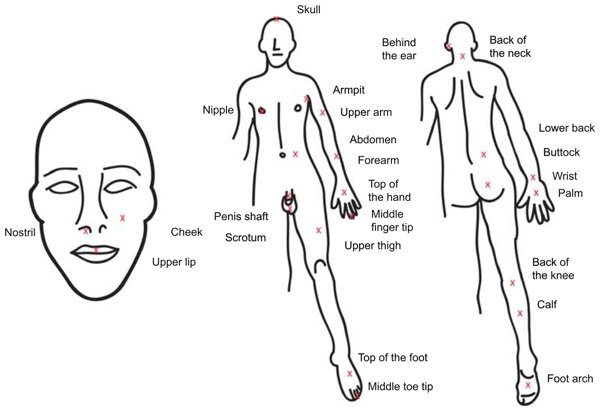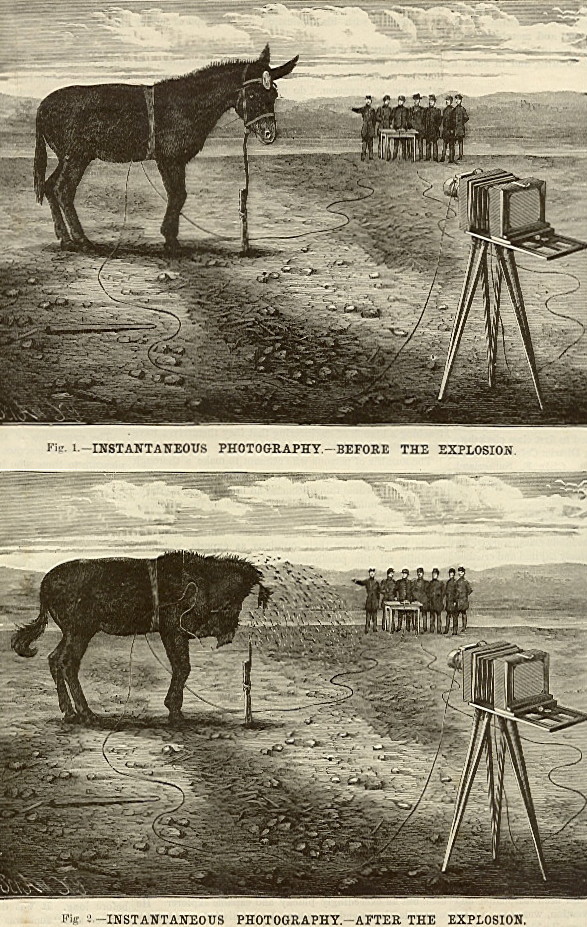Science
The Bruce Effect
If a pregnant rodent is exposed to the scent of an unfamiliar male, she will often spontaneously abort. This is known as the Bruce Effect, after researcher Hilda Bruce who discovered the phenomenon while working at London's National Institute for Medical Research (NIMR) in the 1950s.It's thought that the female rodent does this in order to make herself ready for mating with the new male — because the new male would probably kill the children of the other father once they were born, so why bother carrying them to term. The trick doesn't work with the scent of a castrated male.
The history of the NIMR (pdf - page 208) offers some interesting details about Bruce's research. The Parkes mentioned was Alan Parkes, her boss:
Knowing how skilful perfumers must be in distinguishing between thousands of different odours, they persuaded some Boake representatives to visit NIMR for the purpose of smelling the mice. They invited them to sniff at pieces of cloth that had each been exposed to different cages of various mouse strains. The perfumers had no difficulty in distinguishing the different strains as all had a unique aroma; they even commented that four of the strains were quite similar – all of which had been bred from one original colony at Hampstead. They also noted that the CBA mouse strain, which was fairly new to NIMR, had a wonderful and pleasantly musky smell that could be of commercial interest in perfume manufacture!

Hilda Bruce
Posted By: Alex - Tue Feb 21, 2017 -
Comments (0)
Category: Science, Experiments, Pregnancy, Perfume and Cologne and Other Scents
Most painful places to get stung
Before 2014, science had information about which insect species delivered the most painful sting, but it didn't have info about how the painfulness of stings varied by body location. So Cornell University graduate student Michael Smith set about to correct this omission. He used honey bees to sting himself in 25 body locations and then rated the painfulness of the stings on a 1-10 scale. He published his results in the online journal Peer J (Apr 3, 2014, "Honey bee sting pain index by body location").From the article:
And the results:
In 2015, Smith received an Ig Noble Prize for his efforts.

Posted By: Alex - Tue Jan 31, 2017 -
Comments (4)
Category: Science, Experiments, Pain, Self-inflicted and Otherwise
Theory of Continental Drip
Ormonde de Kay, Jr. first proposed the "theory of continental drip" in Horizon magazine (Winter 1973), although it was more of an observation than a theory. He wrote:
De Kay's article was meant to be tongue-in-cheek, and there have been several elaborations of his theory in the same vein, such as here and here.
However, it's true. Continents and peninsulas do seem to "drip" south — Africa, South America, Baja California, Florida, Greenland, Scandinavia, Italy, Greece, India, Malaysia, Indochina, and Korea.
So why? Is there a reason? De Kay wrote:
But like I said, De Kay wasn't being completely serious. The closest I've been able to find in the way of a genuine scientific response to this mystery is in New Scientist magazine (Dec 18, 1999), when a reader wrote in asking about the dripping continents and received the following response:
In other words, there really is no reason for the dripping. It's just random chance.
Posted By: Alex - Wed Nov 16, 2016 -
Comments (6)
Category: Geography and Maps, Science
LSD for Housewives
Posted By: Paul - Sat Oct 01, 2016 -
Comments (5)
Category: Drugs, Psychedelic, Government, Science, Experiments, 1950s
Photographing a mule at the instant its head is blown off by dynamite
Advances in photographic technology that occurred in the 1860s and 70s led to the invention of plates that had exposure times of a fraction of a second. This allowed for "instantaneous photography," as it was called at the time. Moving objects could be frozen in time by the camera.Researchers immediately used this technology to study bodies in motion. Most famously, Eadweard Muybridge in 1878 took a series of images to study the galloping of a horse. Similarly, neurologist Jean-Martin Charcot used instantaneous photography to study the muscular movements of his human patients.
A more unusual application of the technology took place on June 6, 1881, when Mr. Van Sothen, photographer in charge at the United States School of Submarine Engineers in Willett's Point, New York, took an instantaneous photograph of a mule having its head blown off by dynamite. The mule was apparently old and was going to be put down anyway, so it was decided to "sacrifice the animal upon the altar of science."

The resulting photo
Eugene Griffin, First Lieutenant of Engineers, described the details of the experiment in a letter to Lieut. Col. H.L. Abbot:
Several months later Scientific American published an account of the experiment, including several engravings showing before and after scenes:

Scientific American - Sep 24, 1881
Posted By: Alex - Fri Sep 02, 2016 -
Comments (0)
Category: Mad Scientists, Evil Geniuses, Insane Villains, Photography and Photographers, Science, Experiments, Nineteenth Century
Top 20 Bizarre Experiments
After the publication of Elephants on Acid (around 2007), I decided that it would be a good idea to have a website to help promote the book. Something where I would feature some content from the book, as well as post new stuff related to weird science.Most of the good domain names (including, at the time, ElephantsOnAcid.com) were already taken. So I ended up creating a site at MadScienceMuseum.com.
I added some content to the site, and then, after a while, I stopped. The site lay dormant, without updates, and largely without visitors.
Fast forward to the present. It recently occurred to me that it was stupid to keep paying to keep MadScienceMuseum.com online when hardly anyone visits it, and all the content on it would be perfectly appropriate for WU, which does have visitors.
So I'm getting rid of the "Mad Science Museum" and migrating all the content over to WU. It'll be a slow process, but if you notice me doing additional posts about weird science stuff, that's the reason.
The first thing I've migrated is my list of the Top 20 Most Bizarre Experiments of All Time.

Posted By: Alex - Tue Aug 30, 2016 -
Comments (5)
Category: Mad Scientists, Evil Geniuses, Insane Villains, Science, Experiments
Adolph Heilborn’s Theories on Women
I can learn little personally about Adolf Heilborn (1873-1941). But his book THE OPPOSITE SEXES caused a bit of a stir when it appeared in 1927, given that he described the female human as the missing link between ape and male human. Naturally, there was, um, a little pushback.



Original article here.
Here is the bio of his opponent.

But maybe it was all a joke! If this bookplate belongs to the same fellow, we can see he had a sense of humor.

Posted By: Paul - Fri Aug 26, 2016 -
Comments (7)
Category: Animals, Eccentrics, Feminism, Forgotten Figures and Where Are They Now?, Science, Anthropology, Stereotypes and Cliches, 1920s, Men, Women
The scientist who feared inhaling beer cans
Back in 1969, air-pollution researcher Alfred Hulstrunk had arrived at the pessimistic conclusion that pollution levels were getting so bad that within 10 to 15 years every man, woman, and child would need to wear a breathing helmet to survive outdoors. And within 20 years, he predicted, everyone would have to live in domed cities.Part of the problem, Hulstrunk believed, was all the stuff that society produced, such as "plastic beer containers that can be burned instead of just discarded." When burned, the beer cans added to air pollution. He noted, "Aesthetically you improve your area so that you don't have beer cans along the road, but now you are breathing beer cans."
Therefore, Hulstrunk had prepared for the future by designing an air pollution survival suit "to prevent inhaling beer cans or any other matter."

Corsicana Daily Sun - Dec 23, 1969

Arizona Republic - Dec 21, 1969
Note: It looks like Hulstrunk is still around, now aged 90. He recently gave a talk at Cedars of Lebanon State Park.
Posted By: Alex - Mon Aug 08, 2016 -
Comments (8)
Category: Predictions, Yesterday’s Tomorrows, Science, 1960s
Rev. irwin Moon, Science Preacher

Obituary here.
Posted By: Paul - Fri Jul 15, 2016 -
Comments (0)
Category: Eccentrics, Religion, Science, 1930s
Weird pupils let octopuses see their colorful gardens
When I first saw this headline I thought it was talking about weird school kids, and I was definitely intrigued. What it was actually about was interesting, but not as interesting as an article about freaky kids luring octopuses into their gardens would have been. But I still like the headline.
Posted By: Alex - Sat Jul 09, 2016 -
Comments (2)
Category: Journalism, Science

| Who We Are |
|---|
| Alex Boese Alex is the creator and curator of the Museum of Hoaxes. He's also the author of various weird, non-fiction, science-themed books such as Elephants on Acid and Psychedelic Apes. Paul Di Filippo Paul has been paid to put weird ideas into fictional form for over thirty years, in his career as a noted science fiction writer. He has recently begun blogging on many curious topics with three fellow writers at The Inferior 4+1. Contact Us |




